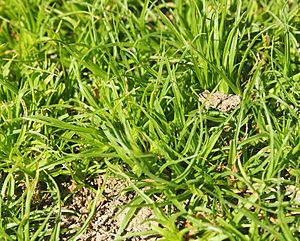Dwarf flat sedge facts for kids
Quick facts for kids Dwarf flat sedge |
|
|---|---|
 |
|
| Cyperus pygmaeus | |
| Scientific classification | |
| Genus: |
Cyperus
|
| Species: |
pygmaeus
|
The Cyperus pygmaeus, also called the dwarf flat sedge, is a small plant from the sedge family, Cyperaceae. It grows naturally in Australia.
About the Dwarf Flat Sedge
This small plant is an annual herb, meaning it lives for only one growing season. It usually grows to be about 5 centimeters (2 inches) tall. Its roots are reddish, and its stems, called culms, are smooth and have three sides. These stems can be anywhere from 1 to 20 centimeters tall and about 1.5 millimeters wide. The leaves of the dwarf flat sedge are usually not much longer than its stems.
The plant produces green-brown flowers. In warmer places, it blooms between July and August. In cooler areas, you might see its flowers later in the summer, around January.
How It Was Named
The dwarf flat sedge was first officially described in 1773 by a scientist named Christen Friis Rottbøll. He wrote about it in his book, Descriptionum et Iconum Rariores et pro maxima parte novas plantas.
Sometimes, plants get different names over time. For the dwarf flat sedge, other names that have been used include Juncellus pygmaeus and Cyperus michelianus subsp. pygmaeus. These are called synonyms, which are like other names for the same plant.
Where It Grows
You can find the dwarf flat sedge in most parts of mainland Australia. This includes Western Australia, the Northern Territory, South Australia, Queensland, New South Wales, and Victoria.
In Western Australia, this plant likes to grow near streams and creeks. It also grows around areas called clay pans, which are flat, shallow areas where water collects. It prefers to grow in soils that are a mix of loam and silt.

